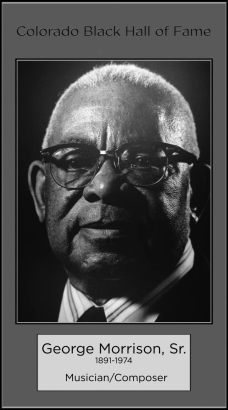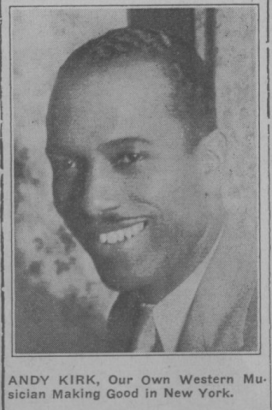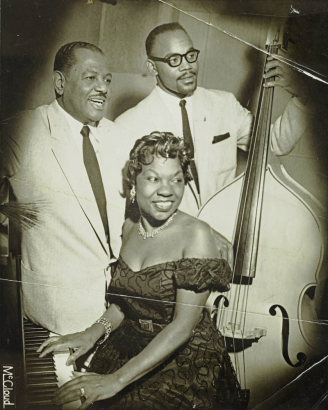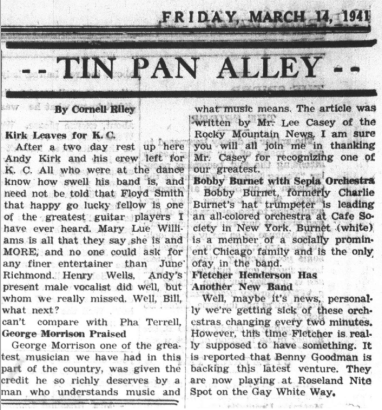This is part two of the series about jazz in the Five Points neighborhood and Denver. If you are interested in reading part one, which focuses on jazz venues, check out that article.
Five Points gained the reputation as being the spot where internationally known musicians, such as Duke Ellington and Billie Holiday, played. However, traveling musicians weren’t the only ones who found a welcoming community. Support for the arts was strong in Five Points, and the neighborhood gave up-and-coming musicians a chance to thrive. George Morrison was one of these musicians.
Born in Missouri to formerly enslaved parents who were also musically talented, George Morrison started playing the violin and guitar by age eight. In 1911, he married, settled in Denver, and studied under acclaimed violinist David Abramowitz and later at the Chicago Conservatory. From extensive touring to starting his own band, the George Morrison Jazz Orchestra, Morrison enjoyed an accomplished musical career. His group toured locally and nationally and recorded an album for Columbia Records as Morrison’s Singing Jazz Orchestra. The newspapers advertised them as “The Greatest Colored Orchestra in the World” and also referred to Morrison as, “The Colored Paul Whiteman.” Paul Whitman was a white, internationally known bandleader from Denver. Paul’s father, Wilburforce James, was the music supervisor for Denver Public Schools and tutored saxophonist Jimmie Lunceford. In addition to playing in and managing several different groups, Morrison mentored other musicians and was soon known as “The Professor.”
Several Denverite musicians who were part of Morrison's groups eventually became successful entertainers themselves. Hattie McDaniel sang for Morrison’s Melody Hounds group before becoming the first African American to win an Oscar.
Andy Kirk played the saxophone and tuba for the George Morrison Orchestra in 1918 and later led the popular swing band, Twelve Clouds of Joy. Jimmie Lunceford played the alto saxophone for the orchestra before going out on his own. By 1935, he was a well-known bandleader for his own orchestra and had developed his own style dubbed “the Lunceford two-beat.”
Outside of Morrison’s protégés, other locals made names for themselves in Denver. Jazz pianist Charlotte Mosley Cowens was known for her unique style as she learned to play the piano by ear. Louise Duncan was a self-taught jazz pianist known to many as “Colorado’s First Lady of Jazz.” She often played with Charlie Burell. Burell was the first African American in the Colorado Symphony and started his career with the Al Rose Trio, which included Al Rose and Lee Arellano. They were the first integrated group in Colorado; Rose was Jewish, and Arellano was Latino.
Residents of Five Points that wanted to know who was playing when and where needed to look no further than their local newspaper, The Colorado Statesman. The column, “Tin Pan Alley,” by Cornell Riley featured articles on local and traveling musicians and even took polls on the readers' favorite bands.
If you are interested in learning more, come visit the Western History reading room at the Central Library during regular business hours or check out the resources below. Note that the manuscript collections used for this blog are usually held at the Blair Caldwell African American Research Library, but due to construction, they are being held at the Central Library location until 2023.






Comments
Interesting article. I didn
Interesting article. I didn't know that Jimmy Lunceford was from Denver. I didn't know that Paul Whiteman was from here either. It's funny that George Morrison was called "the colored Paul Whiteman", as though that was a compliment, when Whiteman was a derivative version of the African American bands of the time. Whiteman was called "The King of Jazz" notwithstanding the presence of musicians like Duke Ellington, Louis Armstrong, and King Oliver, all of whom had far greater influence on the music than Whiteman.
Thanks for reading, Jude! I'm
Thanks for reading, Jude! I'm glad you found the article interesting and learned a few new facts. To clarify, Lunceford was born in Mississippi but moved to Denver when he was an adolescent.
Your point re Paul Whiteman…
Your point re Paul Whiteman as “King of Jazz” is ironic since it was Duke Ellington who confirmed the title: “Paul Whiteman was known as the King of Jazz, and no one as yet has come near to carrying that title with more certainty and dignity.”
Your point re Paul Whiteman…
Your point re Paul Whiteman as “King of Jazz” is ironic since it was Duke Ellington who confirmed the title: “Paul Whiteman was known as the King of Jazz, and no one as yet has come near to carrying that title with more certainty and dignity.”
Thanks for the research,
Thanks for the research, Michelle. So much musical history in our own backyard. No wonder KUVO was located there for so many years. Cheers to WHG staff for always diverse historical articles. Pls continue.
Glad you enjoyed it, Peter!
Glad you enjoyed it, Peter!
What's with the Columbia LP?
What's with the Columbia LP? He only released one side of a '78. He pissed off the mafia who ran Columbia by recording demos for Victor. Those would be something to hear, nobody has ever found them.
Hmm, I'm not sure. But it
Hmm, I'm not sure. But it sounds like an interesting topic to look into!
Add new comment